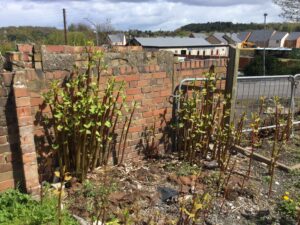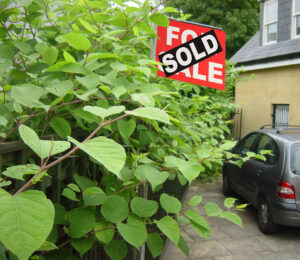Environet: Japanese knotweed doesn’t need to be a deal-breaker
Environet has written an article that discusses Japanese knotweed and why its presence doesn’t need to be a deal-breaker.
As Japanese knotweed continues to spread across the country, now affecting almost a million households, people are becoming better informed about how to identify it, deal with it effectively and preserve the value of their property when they come to sell.
A great deal of work has been done over the last decade to raise awareness of knotweed. Every year we carry out a YouGov survey to determine awareness levels and the results consistently show that between 75 and 82% of people in the UK know about the plant.
With that awareness has come knowledge, and with knowledge comes power. While we thankfully see less scaremongering (no, knotweed can’t grow directly through concrete!), there is much greater awareness of the very real risks it poses and what buyers can do to protect their property from damage and diminution in value – and to protect themselves from the risk of a legal case against them.
The impact of changes to RICS Guidance
Two years ago, RICS revised its Japanese Knotweed Guidance for surveyors, scrapping the blunt ‘7 metre rule’ in favour of a more nuanced approach that considers the plant’s impact on the use and enjoyment of gardens as well as the risk of damage to property.
RICS recognised that in the vast majority of cases, Japanese knotweed is treatable with professional help and that with a Management Plan in place, lenders should be reassured that the problem is being properly dealt with. There is no reason why property transactions should be hindered, as long as the buyer is fully aware of what they’re taking on, the correct paperwork is in place and the property value (and therefore the mortgage lender) is protected.
Transparency is key
Changes to the Guidance Note have provided some much-needed clarification to the previously very ambiguous TA6 knotweed question. However, the consequence is that without digging up the ground, it’s almost impossible to answer ‘No’, which is why a larger proportion of sellers now opt to respond ‘Not known’. Effectively, the onus has switched from the seller to the buyer, who is then left to undertake their own enquiries.
Any buyer or seller who is unsure whether their property, or one they wish to buy, is affected by knotweed, can commission a JustCheck™ survey. Environet’s expert surveyors will check the property for any sign or suspicion of knotweed, and where possible on adjoining land within 3 metres. Assuming none is found or suspected, a 5-year warranty is provided to cover up to £20,000 of treatment in the very unlikely event the plant should later appear.
Herbicide versus excavation
If homeowners tackle knotweed correctly, any reduction in value can be minimised, but indisputably the best way to preserve property values is to excavate the plant from the ground.
The revised RICS Guidance caused some confusion in this regard, since it highlighted control of knotweed as the primary goal, rather than eradication by removal.
In fact, there are very good reasons to make eradication the objective. It’s an instant fix and when buyers come to sell, even though they will still need to declare that knotweed was present, as long as there’s an insurance-backed guarantee (IBG) for the work buyers can be reassured that the problem has been dealt with once and for all.
In contrast, herbicide treatment needs to be carried out over 2 – 3 growing seasons (years), meaning buyers inherit the problem, and even if there’s no above ground growth visible, the rhizome remains in the ground often in a dormant state. Although it can last for many years, dormancy can be broken at any time – particularly if building work takes place in the future, thereby disturbing the ground and prompting the plant to regrow.
According to a YouGov survey of over 2,000 people we undertook in 2022, only 20% would be comfortable buying a property that had been herbicide treated for a knotweed infestation, compared to 50% who would be comfortable buying a property with knotweed where the plant had been excavated from the ground. Understandably, buyers are less reassured following herbicide treatment and are more likely to either walk away from the property or negotiate a more significant discount off the price to reflect the risk they’re taking on, as well as the associated ‘knotweed stigma’.
Upfront approach enabled London homeowner to sell easily
Suzannah Harrison and her husband sold their 2-bedroom flat near Finsbury Park in North London, aware that a past knotweed infestation in the back garden could cause issues. Before marketing their home, they instructed Environet to carry out a professional survey and remove the plant, providing an insurance-backed guarantee for ten years.
Suzannah said:
“We were upfront and honest from the start.
“We made sure we had a professional management plan in place, including an insurance-backed guarantee, and whilst we didn’t advertise the fact the property had had knotweed, as soon as a potential buyer showed interest our estate agent brought it up immediately.
“We also ticked the box on the TA6 Seller’s Information Form, stating it had been present.
“If knotweed is properly treated with the appropriate guarantee, you shouldn’t have to knock the price down significantly.
“We found a buyer pretty quickly and they didn’t beat us down on price as we’d already paid for the treatment.
“They were reassured by the paperwork and as long as the 10-year guarantee could be transferred to them, which it could, they were happy to proceed.
“I’d advise anyone in our situation to just be honest and get everything sorted before you go to market.
“It doesn’t need to be a deal-breaker.”
Five steps to successfully selling a property with Japanese knotweed:
1. Commission a Japanese knotweed survey to determine the extent of the problem and the best course of action.
2. Put a professional treatment plan in place before marketing the property and insist that an insurance-backed guarantee is provided for the work.
3. Be upfront with potential buyers from the start, answering honestly on the TA6 form.
4. Reassure buyers by providing copies of the paperwork relating to the Japanese Knotweed Management Plan and the IBG certificate.
5. If you are unsure whether a property is affected by knotweed, find out for certain with a JustCheck™ survey.
Kindly shared by Environet UK


















